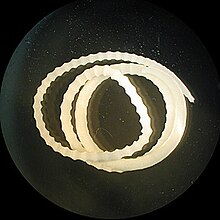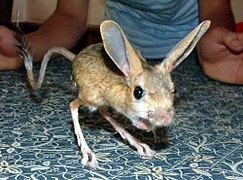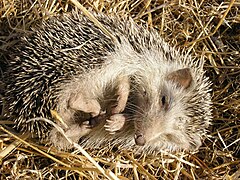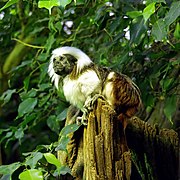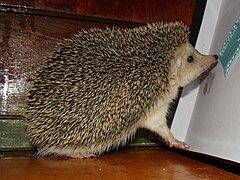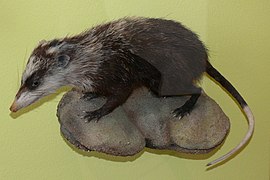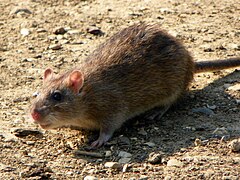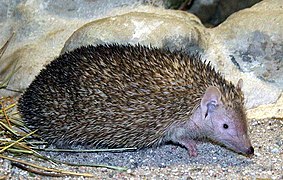|
Moniliformidae
Moniliformidae is a family of parasitic spiny-headed (or thorny-headed) worms. It is the only family in the Moniliformida order and contains three genera: Australiformis containing a single species, Moniliformis containing eighteen species and Promoniliformis containing a single species. Genetic analysis have determined that the clade is monophyletic despite being distributed globally. These worms primarily parasitize mammals, including humans in the case of Moniliformis moniliformis, and occasionally birds by attaching themselves into the intestinal wall using their hook-covered proboscis. The intermediate hosts are mostly cockroaches. The distinguishing features of this order among archiacanthocephalans is the presence of a cylindrical proboscis with long rows of hooks with posteriorly directed roots and proboscis retractor muscles that pierce both the posterior and ventral end or just posterior end of the receptacle. Infestation with Monoliformida species can cause moniliformiasis, an intestinal condition characterized as causing lesions, intestinal distension, perforated ulcers, enteritis, gastritis, crypt hypertrophy, goblet cell hyperplasia, and blockages. Taxonomy and descriptionSpecies of the family Moniliformidae are usually pseudosegmented and have a cylindrical proboscis with longitudinal rows of hooks that have posteriorly directed roots. Moniliformidae are further characterized by the presence of a simple, double-walled proboscis receptacle with the outer wall having spirally aligned muscle fibers (with the exception of Australiformis), brain at posterior end of receptacle, and dorsal and ventral lacunar canals.[2][3] The proboscis retractor muscles pierce both the posterior and ventral end or just posterior end of the receptacle.[4] The cerebral ganglion is in the mid to posterior region, and the lemnisci are long and flat and not bound to the body wall. These worms also lack protonephridia and males have eight cement glands, each with a giant nucleus, which are used to temporarily close the posterior end of the female after copulation.[2][3][5] Genetic analysis has been conducted on four species: Moniliformis moniliformis, M. saudi, M. cryptosaudi and M. kalahariensis.[6][7] Based on these results, Moniliformidae has been determined to be monophyletic.[6][7]
GeneraThere are three genera and twenty living species in the order Moniliformida.[6][10][11][a] AustraliformisAustraliformis is a monotypic genus that infest marsupials in Australia and New Guinea. It was described by Schmidt and Edmonds in 1989.[2] Its body consists of a proboscis armed with hooks which it uses to pierce and hold the gut wall of its host, and a long trunk. It contains a single species, Australiformis semoni. This genus resembles species in the genus Moniliformis but is characterized by a lack of spiral muscles in the outer wall of the proboscis receptacle. The proboscis is armed with 12 rows of 13 to 15 hooks which are used to attach themselves to the small or large intestines of the host. The female worms range from 95 to 197 millimetres, long virtually all of which is the trunk, and 1.75 to 3.5 millimetres wide. There is pronounced sexual dimorphism in this species as females are around twice the size of the males whose trunks range from 46 to 80 millimetres long and 2 millimetres wide.[2] Infestation of marsupials by A. semoni may cause debilitating inflammation of the stomach (gastritis) with granulomatous ulcers.[12] MoniliformisThe genus Moniliformis Travassos, 1915 contains eighteen species. Description of the genus is the same as the family Moniliformidae with the exception of possessing spiral muscles in the outer wall of the proboscis receptacle[2] and a single distinct kind of proboscis hooks.[13] PromoniliformisThe genus Promoniliformis Dollfus and Golvan, 1963[14] is characterized by possessing two distinct kinds of proboscis hooks.[13] There is only one species in this genus. It contains a single species P. ovocristatus. HostsMoniliformidae species are found in the intestines parasitizing mammals and occasionally birds.[4] Intermediate hosts are mostly cockroaches but also other insect groups.[6] Infestation can cause moniliformiasis, which is characterized as lesions in the intestines, intestinal distension, perforated ulcers, enteritis, crypt hypertrophy, goblet cell hyperplasia, and occlusions of the intestinal tract in the gray squirrel (Sciurus carolinensis).[15]
Notes
References
|
|||||||||||||||||||||||
